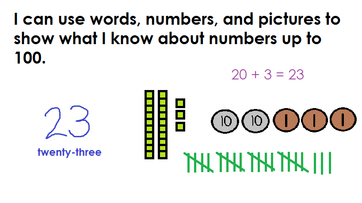 Sample grade 2 Math outcome in student-friendly language
Sample grade 2 Math outcome in student-friendly language It is considered a better teaching practice to post curricular outcomes in the classroom, so students can see what they are expected to learn and why they are supposed to be learning it. Wouldn't it be great if students could articulate what they are learning and why they need to learn it? If you asked a student what they are learning about and why, wouldn't it be tremendous if they NEVER used any of the following responses?
- "because I'm supposed to know it"
- "It'll be on the test"
- "I don't know"
We can make learning more meaningful for students by posting curricular outcomes and referring to them throughout the learning process. This practice is connected to UDL, specifically in the area of multiple means of engagement - the why of learning, which according to CAST, helps foster purposeful, motivated learning. When we help students understand what they are learning and why they need to learn it, it instills a sense of purpose, which can increase motivation and engagement.
Depending on the age of students, it may be necessary to adjust the wording of curricular outcomes so that students can genuinely understand them. Education is full of jargon. Curriculum is no exception. For example, here is a grade two Math outcome (New Brunswick curriculum): Students will represent and describe numbers to 100, concretely, pictorially, and symbolically. Posting this outcome as is for six and seven year olds makes little sense because they would not understand what it means. However, students would have a better understanding of what they are expected to learn if this outcome was re-worded to be more student-friendly.
A student-friendly outcome might look something like this: I can use words, numbers, and pictures to show what I know about numbers up to 100. Teachers can post this outcome in the classroom and refer to it throughout instruction. In whole-class discussions, in small groups, or with a partner, students can explain how they have met, or are working towards meeting the outcome. Students will develop a better understanding of why they are doing activities in class (e.g. showing numbers with base ten blocks, ten frames, tallies, practicing counting, singing counting songs, etc), which will promote student engagement.
Think of the outcome as a string that connects the learning activities. Selected activities in the classroom are not just a random set of tasks chosen on the teacher's whim just to keep students busy... they have a purpose. Their purpose is to help students meet (and hopefully master) curriculum outcomes so they will be prepared for future learning. By posting student-friendly outcomes in a classroom, and discussing how learning activities connect to the outcomes, students will understand why they are expected to do what they are doing, which will increase their intrinsic motivation to learn. Increasing motivation to learn is a key component of promoting multiple means of engagement.
Thinking about making your own student-friendly outcomes? Here are some suggestions to help you get started:
- Work on one subject or unit at a time
- Review the outcomes for this subject/unit
- Reword them using I-can statements
- Eliminate as much jargon as possible
- Simplify the outcomes to age-appropriate language
- Support them with visuals and/or examples
- Ask your grade-level team or PLC to assist you with making student-friendly outcomes. Two heads are better than one!
- Post them on your wall (one or two at a time, as you are working toward that outcome), introduce them to your students, and refer to them often throughout instruction

